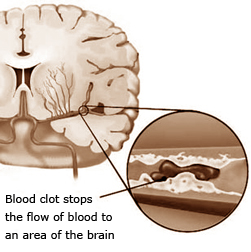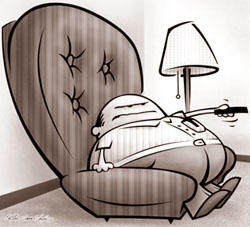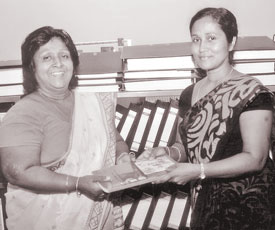
Stop stressing or you will get a stroke!
by Nilma DOLE

Dr. Lal Panapitiya |

Dr. Padma Gunaratne |
"Stroke is the second most common cause of death after heart attacks
in Sri Lanka", said Dr. Padma Gunaratne, the Director of the World
Stroke Association and the Sri Lanka Stroke Association. Speaking to the
Sunday Observer, the doctor said that preventing strokes would be
preventing three of the risk factors of the disease.
"The causes of stroke can be attributed to a lack of a proper diet,
lack of exercise, smoking and stress," said Dr.Gunaratne. She commented,
"About 3% to 5% of the Sri Lankan population are affected by strokes and
a significant proportion are at risk. In Sri Lanka, 30% to 45% of males
are prone to strokes because of the bad habit of smoking". Those who
have high blood pressure, high cholesterol and diabetes are at a risk of
stroke if they don't control their condition. According to Dr.Gunaratne,
10% of stroke victims die within the first month, 50% are severely
disabled and 30% return back to normal after making changes in their
lifestyle.
The National Hospital of Sri Lanka installed its first CT scan nearly
20 years ago and today, there are more than 19 machines installed in
state hospitals under the Ministry of Health. "A brain scan is a basic
investigation for stroke, equivalent to an ECG when diagnosing a
myocardial infarction" said the doctor. Further she commented, "However
those from rural parts of Sri Lanka need to be scanned. Although it is
clear that we need to have a few more CT machines, doctors should
request a CT brain scan for all stroke patients." Strokes happen when
blood flow to your brain stops which is dangerous because within
minutes, brain cells begin to die. There are two kinds of stroke. The
more common kind, called ischemic stroke, is caused by a blood clot that
blocks or plugs a blood vessel in the brain. The other kind, called
haemorrhagic stroke, is caused by a blood vessel that breaks and bleeds
into the brain. "Mini-strokes" or transient ischemic attacks (TIAs),
occur when the blood supply to the brain is briefly interrupted. A
stroke can be devastating to individuals and their families, robbing
them of their independence as it is the most common cause of adult
disability.
|

How a stoke occurs |
Director of the Non-Communicable Diseases unit of the Ministry of
Health, Dr. Lal Panapitiya said "We have a trauma unit for stroke
victims in the major hospitals in Sri Lanka but we have to develop these
centres with emergency care services and counselling." He said that
strokes should be properly understood not only by patients but family
members because it is a financial and physical burden for all. Recently,
there was a 20% increase in the number of stroke patients in Sri Lanka
because many have not been adopting methods of preventing strokes.
"We have plans in developing 'curative care' programmes and a
community-based rehabilitation programme to help stroke victims overcome
a stroke and prevent another one," said Dr. Panapitiya. He further
commented, "We also get valuable assistance from the Ministry of Social
Services and Welfare for providing stroke victims with donations." A
significant portion of the government's expenditure is spent on stroke
patients to provide rehabilitation facilities and medicine at a nominal
cost but everything can be prevented if people take care. "We have a
dearth of adequately allocated beds for stroke patients at the National
Hospital of Sri Lanka depriving the treatment for a significant
proportion of deserving patients" concluded Dr. Panapitiya. As the life
expectancy of Sri Lankans increase, it is predicted that in 2020, about
20% of the population in Sri Lanka will surpass the age of 65 years old
showing that there will be a significant stroke burden for the country
then. Strokes affect 11 patients per 1,000 population in Sri Lanka being
the second leading cause of hospital deaths. Stroke is the world's main
cause of adult disability and according to the World Health
Organization, the loss of productivity caused by the disability and the
cost involved in the management of stroke could be significant enough to
have an impact on the economy of a country.
So stop stressing, eat well and exercise while maintaining a good
equilibrium to prevent getting a stroke.
Stroke Prevention Guidelines:
1. Know your blood pressure. If you have
blood pressure, take at least two cups of cocoa a day.
2. Find out if you have atrial fibrillation.
3. If you smoke, stop.
4. If you drink alcohol, do so in
moderation.
5. Find out if you have high cholesterol
6. If you are diabetic, control your blood
sugar
7. Exercise
8. Enjoy a lower sodium (salt), lower fat
diet
9. Circulation (movement of the blood
through the heart and blood vessels) problems
The danger of prolonged TV viewing
By Dr. Catharine Paddock
 Researchers in Australia found that prolonged television viewing was
linked to an increased risk of death, even in people who exercised
regularly, and recommended more be done to encourage people to spend
fewer hours sitting still in front of the TV. Researchers in Australia found that prolonged television viewing was
linked to an increased risk of death, even in people who exercised
regularly, and recommended more be done to encourage people to spend
fewer hours sitting still in front of the TV.
The study, which appeared online on 11 January in the journal
Circulation, is the work of lead author Dr. David Dunstan, a researcher
at the Baker IDI Heart and Diabetes Institute in Melbourne, and
colleagues.
The researchers wrote that studies have been done on television
viewing time and health, but these have focused on links with
cardiovascular risk, and not risk of death. So for this study they
investigated the link between prolonged television viewing time and
all-cause, cardiovascular, cancer and non-cardiovascular/non-cancer
mortality in Australian adults.
One of the surprising things they found was that even for people who
exercised regularly, the risk of death went up the longer they spent in
front of the TV: they suggest the problem was the prolonged periods of
sitting still.
For six years, Dunstan and colleagues followed 8,800 people aged 25
and over who were taking part in the Australian Diabetes, Obesity and
Lifestyle Study (AusDiab) and found that those who said they watched
four or more of TV a day were 46 per cent more likely to die of any
cause and 80 per cent more likely to die of cardiovascular disease
compared to people who said they spent less than two hours a day in
front of their TVs.
The study revealed the following results: The average age of the
participants at enrollment in 1999-2000 was 50 years. 284 deaths
occurred over 58,087 person-years of follow up: 87 due to cardiovascular
disease and 125 due to cancer. After adjusting for age, sex, waist size,
and exercise, the risk of dying from all causes, cardiovascular disease
and cancer went up for each extra hour spent sitting still in front of
the TV every day. Risk of dying from any cause went up by 11 per cent
for each extra TV viewing hour (hazard ratio [HR] for each one-hour
increment was 1.11, with 95 per cent confidence interval [CI] ranging
from 1.03 to 1.20). Risk of dying from cardiovascular disease went up 18
per cent for each extra hour (HR 1.18, 95%CI 1.03-1.35). Risk of dying
from cancer went up 9 per cent for each extra hour (HR 1.09, 95%CI
0.96-1.23). Watching TV for 2 to 4 hours a day increased the risk of
dying from any cause by 13 per cent (adjusted HR 1.13 95%CI 0.87-1.36),
and from cardiovascular disease by 19 per cent (adj HR 1.19, 95% CI,
0.72 to 1.99) compared to watching it for less than 2 hours. Watching TV
for 4 hours or more increased the risk of dying from any cause by 46 per
cent (adj HR1.46, 95%CI 1.04-2.05), and from cardiovascular disease by
80 per cent (adj HR 1.80, 95%CI, 1.00 to 3.25) compared to daily TV
viewing of under 2 hours. The links with cancer mortality and
non-cardiovascular/non-cancer mortality were not significant.
The researchers concluded that:
"Television viewing time was associated with increased risk of
all-cause and CVD mortality."
They recommended that as well as promoting exercise, reducing
prolonged periods of sitting in front of the TV would help prevent
chronic diseases.
This study points to a possible gap in public health messages.
While it is widely acknowledged that sitting for hours on end in
front TVs, computer and video game screens has contributed to the
obesity epidemic in the US and many other nations around the world, the
resulting public health message has tended to encourage people to stop
doing these sedentary activities and take up physical exercise like play
football, swim, or use a treadmill.
But as Dunstan explained to the press, this study highlights a
different view of the problem:
"It's not the sweaty type of exercise we're losing," said Dunstan.
"It's the incidental moving around, walking around, standing up and
utilizing muscles that [doesn't happen] when we're plunked on a couch in
front of a television."
In fact the participants in this study reported exercising on average
between 30 and 45 minutes a day.
There is emerging evidence that prolonged periods of inactivity
affects how our bodies process fats and other substances in a way that
contributes to heart risk, and that avoiding sitting for long periods
can reduce that effect.
Dr. Marc Hamilton, a scientist at Pennnington Biomedical Research
Center, Baton Rouge in Louisiana, USA, studies the biology of
inactivity. He wasn't involved in this study, but said in a press
statement issued by Baker IDI that:
"If you're not up on your feet moving around, you're sedentary."
A study by Nielsen Co, a ratings company, found that Americans spent
an average of 151 hours a month viewing the TV during the fourth quarter
of 2008, which is more than five hours a day.
Dunstan said their study findings are probably also valid for other
sedentary activities such as sitting in front of a computer, reading a
book, driving, or sitting on a bus or train. He said a recent study in
Canada showed that the more time spent sitting for any reason was linked
to a higher risk of death from heart-related and also from any cause.
He was also keen to point out that none of these findings detract
from the importance of also doing exercise that makes you sweat and
increases your heart rate.
However, consider this, when you have had your 8-hour sleep, and you
have done your 30 to 60 minutes exercise every day, what are you doing
for the other 15 hours?
"The implication of these findings is that the extraordinary amount
of sitting can undo the good effects that we know are a benefit when we
get regular exercise," said Dunstan, explaining that research has
revealed muscle movement helps the body process blood sugar and blood
fats:
"The absence of movement can slow down our metabolic processes," he
explained, adding that:
"When we're sitting down or even lying on the couch, we're burning
the equivalent of the energy we burn when we're sleeping."
The authors said one limitation of the study was that the data on TV
viewing time and exercise was taken at enrollment and not verified after
that; however they insist the findings are consistent with other
research.
Hamilton cautioned that while population-based studies such as this
one can only show links and not causes, he said that his own research
into what happens when people and animals become inactive support these
findings.
For example, after a few hours of being inactive, our bodies switch
off an enzyme called lipoprotein lipase that pulls fat from the
bloodstream.
This results in less fat being transported to muscle tissue in
readiness for burning as fuel, and more of it circulating in the blood,
increasing the risk of arterial damage and subsequent cardiovascular
diseases.
Hamilton said that one day of inactivity leads to a 20 per cent fall
in our levels of good cholesterol or HDL, the one that helps move the
bad cholesterol or LDL out of the bloodstream.
Other experts also suggest it's not just about making sure get
intense exercise, while that is also important, we need to add more
routine movement to our daily lives.
In fact, some say even standing still is better than sitting still.
Dr. Gerard Fletcher, a cardiologist at Mayo Clinic, Jacksonville, in
Florida, USA, works at his computer standing up:
"When you stand up, you shuffle around a little bit" said Fletcher:
you use muscles not required when you're sitting or lying down.
"Television Viewing Time and Mortality. The Australian Diabetes,
Obesity and Lifestyle Study (AusDiab)."
medicalnewstoday.com
Cancer Registry and DVD launched
By Nadira GUNATILLEKE
|

Dr. T. D. Indiketiya handing over the Cancer Registry 2005 to
the National Cancer Control Program Director Dr. Neelamani
Paranagama.
|
The National Cancer Control Program launched the cancer registry 2005
and an educational DVD on cancer control and prevention recently. The
cancer registry is an epidemiological report prepared based on all
diagnosed cancers in the Government Cancer Treatment Centres. Cancer
registry 2005 contains cancer incidence data from all cancer units in
the country for the period of 2001-2005.
This is the 7th edition of cancer registry which commenced
publication from 1985. The information available in this document will
be helpful to identify priority cancers and other epidemiological
information to plan intervention programs. This document will also help
researchers for future research projects.
The educational DVD on cancer prevention and control will make the
people aware of the importance of knowing about cancers, its prevention
and early detection which are very important in achieving good results
out of timely treatment. Promotion of healthy lifestyle, prevention of
known modifiable risk factors, early identification of cancers by
identifying early symptoms and signs among symptomatic populations and
offering pain management and supporting care for incurable cancers are
the main strategies in prevention and control of cancers.
Positive behavioral changes among general public is essential in
participation of control and prevention of cancers. To achieve such a
change, awareness among the general public with reference to different
prevention strategies need to be improved.
Japan International Cooperation Agency (JICA) provided financial
support for the collection of relevant data and the World Health
Organisation (WHO) provided financial support for publishing this
registry.
The registry will be distributed to all national and provincial level
program managers. In addition, the registry will also be distributed
among medical schools and other health related academic institutions and
research organisations. The DVD will be distributed among the primary
health care institutions and the MOH offices to be used in health
education and promotion activities conduct in schools, work places and
for the general public.
Pomegranates:
Next treatment for breast cancer
 Pomegranate juice could be the next estrogen-responsive breast cancer
treatment. A new lab study has demonstrated promising results when
evaluating the use of pomegranate juice, as a way of fighting off and
preventing breast cancer. Pomegranate juice could be the next estrogen-responsive breast cancer
treatment. A new lab study has demonstrated promising results when
evaluating the use of pomegranate juice, as a way of fighting off and
preventing breast cancer.
More than 75 percent of all breast cancer cases are fed by estrogen
and there are over 400,000 women dieing annually, around the world.
Researchers with Ohio State University focused on the benefits of
pomegranates in the breast cancer fight. The team discovered the large
red fruit filled with juicy seeds naturally produces a chemical known as
ellagic acid, which seems to help slow and even prevent the growth of
cancer cells in breast tissue.
According to researchers, the pomegranate has recently been noted for
its antioxidants and potential cancer fighting attributes, as well as
its heart healthy benefits. However, the study recently published in
Cancer Prevention Research is the first to take a look at the effects of
the pomegranate on breast cancer and aromatase, an enzyme that plays a
key role in making estrogen and promoting the growth of breast cancer.
In a lab, the team studied the effects of ten ellagitannin-derived
compounds produced by pomegranates, which are thought to potentially
prevent estrogen-related breast cancer. They considered the effects of
the ten compounds on the growth of breast cancer cells and aromatase
activity. Of the ten ellagitannin-derived compounds studied, the
researchers discovered urolithin B was the standout in the fight against
breast cancer.
Researchers have created a scale called the Oxygen Radical Absorbance
Capacity scale (ORAC) which measures the antioxidant level in fruits and
vegetables. Dr. David Hnida, a CBS3 medical editor said, "The higher the
number on the scale, the more antioxidants and disease-fighting
chemicals in the food." Researchers have measured antioxidant levels in
over 200 different fruits and vegetables.
While experts aren't recommending substituting pomegranates for
prescribed medicine yet, we may see the fruit being used in breast
cancer treatment and prevention efforts eventually. Many experts in the
cancer field see the test results as very promising. However, according
to Powel Brown, M.D., Ph.D., chairman of the clinical cancer prevention
department at the University of Texas M.D. Anderson Cancer Center, who
was not involved in the pomegranate and breast cancer study, "More
research on the individual components and the combination of chemicals
is needed to understand the potential risks and benefits of using
pomegranate juice or isolated compounds for a health benefit or for
cancer prevention." In the meantime, women may want to add a pomegranate
to their daily diet as an extra effort to ward off breast cancer.
- healthnews.com
|

